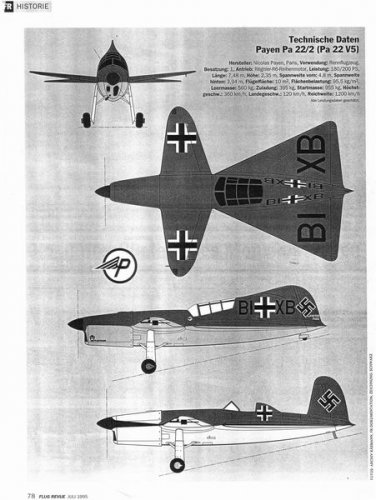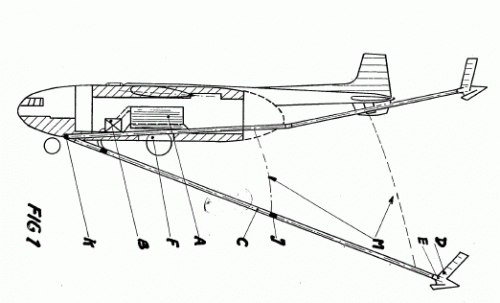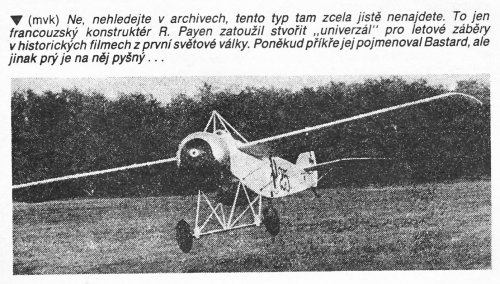- Joined
- 11 March 2006
- Messages
- 8,617
- Reaction score
- 3,729
If we don't want to wait for at least another seven years ... we just have to work it out on our own !
So Deltafan and me worked out a list, that probably isn’t complete, but contains
all designations,we could find.
The designs designated “SP. xxx” were worked out in collaboration with Robert
Sauvage, so aren’t “pure” Payen designs, as are the AP designs, as the “A”
stands for Emile Aubrun. What's still puzzling, are the different designations,
“Pa” and “P”, as we can’t see any relation between the numbers, although they
seem to be used during the same period. Maybe the P-designated designs were
more or less concepts, and only the Pa’s more detailed projecst ?
Or is it just an error in the sources ? Maybe there wasn’t an “official” designation
at all ? Some sources just use, for example the designation “Payen 100”, without
any short form.
Apart from several sources like Cunys "Les Avions Des Combat",
and sites like http://home.att.net/~dannysoar2 and http://museedelta.free.fr ,
our special thanks to Tophe, Hesham and boxkite .
SP.190 : 1932, design for a single engined, light transport/medevac
for 2 crew, 6 stretchers
SP.23 O : ? , wind tunnel model only
SP.240 : 1931, design for a single engined, light transport/medevac
for 1 crew, 1 stretcher
SP-25 : design for the Coupe Deutsch 1933, two engines combined in "I" form (?)
SP-26 : design derivative of the SP-25, one engine, become the Pa-100
SP.260 :1933, first project for a delta canard, retractable landing gear
SP.261 :1933, derived from the SP.260, with fixed gear
BP.1 : 1932, design for a two seats flying wing with one (40 or 75hp) pusher prop
NRP.260 : early designation of the Pa-100R
P.2 : 1933, design for a one seat light aircraft, high trapezoid wing, single engine
(20 hp), built from wood
Pa.100 :1933, delta canard, retractable single wheel, designed for a
Régnier engine
Pa.100R : design developed from the Pa-101, with two Melot ramjet engines
Pa.101 :1934, Pa.100 with a G & R 7KD Titan Major radial engine
Pa.110 : 1936 ?, follow-on project to the Pa.100
Pa.112C1:1938, twin engined fighter (contra props), based on the
Pa.100, mock-up built
AP.10 :1935, small flying wing with 25/27hp, later 40hp engine
AP.12 : , larger single engined flying wing, enclosed cockpit , side by side
seats, one 40/50hp engine
Pa.268 : 1933, first study of the later Pa-22
Pa.22/1R: 1935, design for a Pa-22 with a Melot ram jet
Pa.22 :1939, Pa.22/R1 redesigned and built with a Régnier 6B-01 engine
Pa.22 V5 : designation of the modified PA-22 prototype, first flight on
18th October 1941
Pa.22/3 : design derivative of the Pa-22 with three seats
Pa.22/4 : design derivative of the Pa-22, two seats, the 2 fins are at the tips
of the delta wing, one 220 hp engine
Pa.22/6 : design derivative ot the Pa-22 with larger canards
Pa.22/7 : 1942, design derivative of the Pa-22, with folding canards
(model built for a frenche movie - Retour de flamme - in 1942 [empty]
Pa.22D : 1948, design derivative of the Pa-22 with reversed (or inverted ?) canards
Pa.222 : design derivative of the Pa-22, two seats
Pa.225 : design for the Coupe Deutsch 1939, derivative of the Pa-22, 380/400 hp engine
Pa.240GR (grand raid) : , design derivative of the Pa-22, 315 hp engine
Pa.26 : 1946, design for flyable car/roadable aircraft
PM.30A: design developed from the Pa.22 [empty]
Pa.400 : 1938 : design submitted for Mitsubishi, shipboard fighter bomber
P.200 : 1938: design for a twin engined sports aircraft (contra props)
P.310CB:1937: design for a twin engined fighter bomber (contra props)
Pa.320P : 1936, design, 500 hp, 4 (?) engines
P.321AC:1935: design for a four engined heavy fighter/light bomber (two
nacelles with contra props)
P.323AC3: ?: design probably similar to P.321AC, which is said to have
been derived from it
Pa.330: , design for a delta canard
P.340TP:1937, design for a twin engined transport (contra props)
P.350CD:1934, design for a twin engined racing aircraft (contra props)
P.360PT:1941, design for twin fuselage, twin engined transport
Pa.361: , design for a twin engined canard with long range
Pa.430CV : 1938, design for a racing aircraft, 2 x 650 hp 14 M engines(contra props)
Pa.42/1: , designs for twin boom, twin engined transports with two 300hp engines
Pa.42/5: , designs for twin boom transport with detachable cargo hold, 3 engines
one of them driving the wheels for ground handling.
Pa.46/1 : design for "Fléchair" with Mélot jet engine
Pa.46/2-8: design for versions of the 46/1
Pa.46/13 : design for twin-engined amphibian canard
Pa.46/16 : design for 2-seat touring aircraft
Pa.46/400/410: design for 4-seat touring aircraft
Pa.47 :1950, single engined high wing sports aircraft
Pa.47/3 : , derivative of Pa-47 with tricycle landing gear
Pa.48/3 : , design for a delta wing interceptor, one 2270 kgp Nene jet engine
Pa.48/5 (K50/77) : design for a derivative of the Pa-48/3 with two seats, one piston
engine and pusher prop
Pa.48/6 (K50/78) : single seat derivative of the Pa-48/5
Pa.49 : 1952, small delta wing, jet powered experimental aircraft
Pa.49/2: (or 492 ?) single seat derivative of Pa.49
Pa.49/5: (or 495 ?) twin seat derivative of Pa.49
Pa.50B: , designfor a glider with 4 SNECMA pulsejet engines
Pa.51 : 1956, design for a single engined, high wing, tri-cycle agricultural
aircraft ("Les Ailes", 1956 ?)
Pa.56 : , Fouga-Payen design for a delta wing trainer
Pa.562 : , derivative of the Pa-56, using 70% of the parts of the Fouga-Magister
Pa.57 : , design for a flying wing with two seats, two engines and two fins
Pa.59 : 1954, design for a delta wing tail sitter interceptor
Pa.60 : 1963 , delta wing, 3 (?)-seat touring aircraft, fixed landing gear, 105hp
Hirth engine
Pa.61B : , modified Pa.60,
Pa.61F : 1963, delta wing, 3 (?)-seat touring aircraft, fixed landing gear, 180hp
Lycoming engine, a very similar aircraft was offered for the german market
as "Pa.81"
Pa.61 G : , design derivative of the Pa.61 F with retractable canards
Pa.61 H : , design derivative of the Pa.61 F and G with two 160 kp side by side jet engines
Pa.61O : , design for a 4 seats derivative of the Pa.61, one 200 hp engine
Pa.62 : , design probably similar to Pa.61 with ducted prop
Pa.64 :1955 , flying saucer, powered by one Marboré engine (sometimes designated
as Pa.61)
Pa.65 : , design for flyable car/roadable aircraft, straight wing, twin
boom layout .Maybe other designation Pa.26 ?
Pa.71 : , design for a delta wing racing aircraft with 100hp Continental
engine
Pa.120 : 1940, other designation for the AP-12 flying wing designt
Pa.140 (or K60) : , design probably similar to the Pa.141 (or K.60 B)
Pa.141: , design for a twin boom, single engined pusher prop mid wing aircraft
Pa.149: , design for a two seat derivative of the Pa.49 with two Palas jet engines
Pa.150:1943, design for a twin boom, single engined pusher prop, high wing flying boat
Pa.161 : , delta wing design with canards
Pa.171: 1992, design derivative of Pa.71 ,studied in 1992 with Pa.49 wing
and "rotax" engine
Pa.190 : , twin engined, design probably similar to the Pa-150
PAM-10 : 1959, unfinished (?) flying wing with canards with two engines and three fins.
Pa.240 H : , twin engined, design probably similar to the Pa-150
Pa.249: , design with with retractable landing gear and built in composite
Pa.349: , design for an UAV to watch over woods. Take off on a vehicle and landing
with parachute
Pa.370 : , design probably similar to the Pa-360
Pa.445 : , design probably similar to the Pa-360
Pa.600: , design for a twin engined, twin boom, high wing transport aircraft
So Deltafan and me worked out a list, that probably isn’t complete, but contains
all designations,we could find.
The designs designated “SP. xxx” were worked out in collaboration with Robert
Sauvage, so aren’t “pure” Payen designs, as are the AP designs, as the “A”
stands for Emile Aubrun. What's still puzzling, are the different designations,
“Pa” and “P”, as we can’t see any relation between the numbers, although they
seem to be used during the same period. Maybe the P-designated designs were
more or less concepts, and only the Pa’s more detailed projecst ?
Or is it just an error in the sources ? Maybe there wasn’t an “official” designation
at all ? Some sources just use, for example the designation “Payen 100”, without
any short form.
Apart from several sources like Cunys "Les Avions Des Combat",
and sites like http://home.att.net/~dannysoar2 and http://museedelta.free.fr ,
our special thanks to Tophe, Hesham and boxkite .
SP.190 : 1932, design for a single engined, light transport/medevac
for 2 crew, 6 stretchers
SP.23 O : ? , wind tunnel model only
SP.240 : 1931, design for a single engined, light transport/medevac
for 1 crew, 1 stretcher
SP-25 : design for the Coupe Deutsch 1933, two engines combined in "I" form (?)
SP-26 : design derivative of the SP-25, one engine, become the Pa-100
SP.260 :1933, first project for a delta canard, retractable landing gear
SP.261 :1933, derived from the SP.260, with fixed gear
BP.1 : 1932, design for a two seats flying wing with one (40 or 75hp) pusher prop
NRP.260 : early designation of the Pa-100R
P.2 : 1933, design for a one seat light aircraft, high trapezoid wing, single engine
(20 hp), built from wood
Pa.100 :1933, delta canard, retractable single wheel, designed for a
Régnier engine
Pa.100R : design developed from the Pa-101, with two Melot ramjet engines
Pa.101 :1934, Pa.100 with a G & R 7KD Titan Major radial engine
Pa.110 : 1936 ?, follow-on project to the Pa.100
Pa.112C1:1938, twin engined fighter (contra props), based on the
Pa.100, mock-up built
AP.10 :1935, small flying wing with 25/27hp, later 40hp engine
AP.12 : , larger single engined flying wing, enclosed cockpit , side by side
seats, one 40/50hp engine
Pa.268 : 1933, first study of the later Pa-22
Pa.22/1R: 1935, design for a Pa-22 with a Melot ram jet
Pa.22 :1939, Pa.22/R1 redesigned and built with a Régnier 6B-01 engine
Pa.22 V5 : designation of the modified PA-22 prototype, first flight on
18th October 1941
Pa.22/3 : design derivative of the Pa-22 with three seats
Pa.22/4 : design derivative of the Pa-22, two seats, the 2 fins are at the tips
of the delta wing, one 220 hp engine
Pa.22/6 : design derivative ot the Pa-22 with larger canards
Pa.22/7 : 1942, design derivative of the Pa-22, with folding canards
(model built for a frenche movie - Retour de flamme - in 1942 [empty]
Pa.22D : 1948, design derivative of the Pa-22 with reversed (or inverted ?) canards
Pa.222 : design derivative of the Pa-22, two seats
Pa.225 : design for the Coupe Deutsch 1939, derivative of the Pa-22, 380/400 hp engine
Pa.240GR (grand raid) : , design derivative of the Pa-22, 315 hp engine
Pa.26 : 1946, design for flyable car/roadable aircraft
PM.30A: design developed from the Pa.22 [empty]
Pa.400 : 1938 : design submitted for Mitsubishi, shipboard fighter bomber
P.200 : 1938: design for a twin engined sports aircraft (contra props)
P.310CB:1937: design for a twin engined fighter bomber (contra props)
Pa.320P : 1936, design, 500 hp, 4 (?) engines
P.321AC:1935: design for a four engined heavy fighter/light bomber (two
nacelles with contra props)
P.323AC3: ?: design probably similar to P.321AC, which is said to have
been derived from it
Pa.330: , design for a delta canard
P.340TP:1937, design for a twin engined transport (contra props)
P.350CD:1934, design for a twin engined racing aircraft (contra props)
P.360PT:1941, design for twin fuselage, twin engined transport
Pa.361: , design for a twin engined canard with long range
Pa.430CV : 1938, design for a racing aircraft, 2 x 650 hp 14 M engines(contra props)
Pa.42/1: , designs for twin boom, twin engined transports with two 300hp engines
Pa.42/5: , designs for twin boom transport with detachable cargo hold, 3 engines
one of them driving the wheels for ground handling.
Pa.46/1 : design for "Fléchair" with Mélot jet engine
Pa.46/2-8: design for versions of the 46/1
Pa.46/13 : design for twin-engined amphibian canard
Pa.46/16 : design for 2-seat touring aircraft
Pa.46/400/410: design for 4-seat touring aircraft
Pa.47 :1950, single engined high wing sports aircraft
Pa.47/3 : , derivative of Pa-47 with tricycle landing gear
Pa.48/3 : , design for a delta wing interceptor, one 2270 kgp Nene jet engine
Pa.48/5 (K50/77) : design for a derivative of the Pa-48/3 with two seats, one piston
engine and pusher prop
Pa.48/6 (K50/78) : single seat derivative of the Pa-48/5
Pa.49 : 1952, small delta wing, jet powered experimental aircraft
Pa.49/2: (or 492 ?) single seat derivative of Pa.49
Pa.49/5: (or 495 ?) twin seat derivative of Pa.49
Pa.50B: , designfor a glider with 4 SNECMA pulsejet engines
Pa.51 : 1956, design for a single engined, high wing, tri-cycle agricultural
aircraft ("Les Ailes", 1956 ?)
Pa.56 : , Fouga-Payen design for a delta wing trainer
Pa.562 : , derivative of the Pa-56, using 70% of the parts of the Fouga-Magister
Pa.57 : , design for a flying wing with two seats, two engines and two fins
Pa.59 : 1954, design for a delta wing tail sitter interceptor
Pa.60 : 1963 , delta wing, 3 (?)-seat touring aircraft, fixed landing gear, 105hp
Hirth engine
Pa.61B : , modified Pa.60,
Pa.61F : 1963, delta wing, 3 (?)-seat touring aircraft, fixed landing gear, 180hp
Lycoming engine, a very similar aircraft was offered for the german market
as "Pa.81"
Pa.61 G : , design derivative of the Pa.61 F with retractable canards
Pa.61 H : , design derivative of the Pa.61 F and G with two 160 kp side by side jet engines
Pa.61O : , design for a 4 seats derivative of the Pa.61, one 200 hp engine
Pa.62 : , design probably similar to Pa.61 with ducted prop
Pa.64 :1955 , flying saucer, powered by one Marboré engine (sometimes designated
as Pa.61)
Pa.65 : , design for flyable car/roadable aircraft, straight wing, twin
boom layout .Maybe other designation Pa.26 ?
Pa.71 : , design for a delta wing racing aircraft with 100hp Continental
engine
Pa.120 : 1940, other designation for the AP-12 flying wing designt
Pa.140 (or K60) : , design probably similar to the Pa.141 (or K.60 B)
Pa.141: , design for a twin boom, single engined pusher prop mid wing aircraft
Pa.149: , design for a two seat derivative of the Pa.49 with two Palas jet engines
Pa.150:1943, design for a twin boom, single engined pusher prop, high wing flying boat
Pa.161 : , delta wing design with canards
Pa.171: 1992, design derivative of Pa.71 ,studied in 1992 with Pa.49 wing
and "rotax" engine
Pa.190 : , twin engined, design probably similar to the Pa-150
PAM-10 : 1959, unfinished (?) flying wing with canards with two engines and three fins.
Pa.240 H : , twin engined, design probably similar to the Pa-150
Pa.249: , design with with retractable landing gear and built in composite
Pa.349: , design for an UAV to watch over woods. Take off on a vehicle and landing
with parachute
Pa.370 : , design probably similar to the Pa-360
Pa.445 : , design probably similar to the Pa-360
Pa.600: , design for a twin engined, twin boom, high wing transport aircraft




